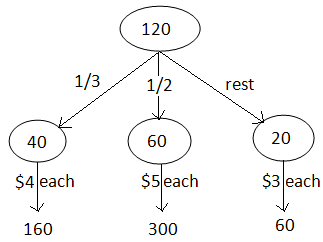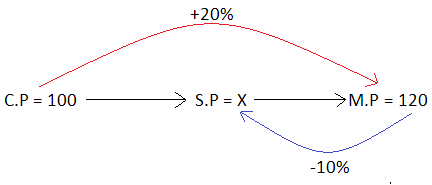WORKSHEET ON MARKUP AND MARKDOWN
Subscribe to our ▶️ YouTube channel 🔴 for the latest videos, updates, and tips.
1. A computer store used a markup rate of 40%. Find the selling price of a computer game that cost the retailer $25.
2. A store uses a 40% markup on cost. Find the cost of a pair of shoes that sells for $63.
3. A product that regularly sells for $425 is marked down to $318.75. What is the discount rate?
4. A trader cheats his customer to make a profit by stating that he sells at cost price but gives his customers only 800 grams. for every 1000 grams. What is the mark up rate?
5. Mr. Lenin sold a chair at a loss of 15%. If he had sold at a mark up rate of 10%, he would have got $100 more. What is the cost price of the chair?
6. I purchased 120 books at the rate of $3 each and sold 1/3 of them at the rate of $4 each. 1/2 of them at the rate of $ 5 each and rest at the cost price. Find my profit percentage.
7. A trader marks his goods 20% above the cost price and allows a discount of 10% for cash. Find the mark up rate.
8. A person buys 8 articles for $15 and sells them at 10 for $18. Find the gain or loss percentage.
9. Sum of the cost price of two products is $50. Sum of the selling price of the same two products is $52. If one is sold at 20% and other one is sold at 20% loss, find the cost price of each product.
10. On selling an item, a trader gets a profit of $20. If the selling price is five times the profit, find the mark up rate.

1. Answer :
Selling price = (100 + m)% ⋅ C . P
Substitute m = 40 and C. P = $25.
= (100 + 40)% ⋅ 25
= 140% ⋅ 25
= 1.4 ⋅ 25
= $35
2. Answer :
S. P = (100 + m)% ⋅ Cost price
Cost price = S. P/(100 + m)%
Substitute S. P = 63 and m = 40.
Cost price = 63/(100 + 40)%
= 63/140%
= 63/1.4
= $45
3. Answer :
Regular price = $ 425
Marked down price = $ 318.75
Marked down value = 425 - 318.75 = 106.25
Marked down rate = (106.25/425) ⋅ 100%
= 25%
4. Answer :
Cheated Value = 1000 - 800 = 200
False weight = 800
Mark up rate = (Cheated value/False weight) ⋅ 100%
Mark up rate = (200/800) ⋅ 100%
= 25%
5. Answer :
Let x be the cost price of the chair.
S. P (-15%) = 85% of x
S. P (-15%) = 0.85x ----(1)
S. P (+10%) = 110% of x
S. P (+10%) = 1.1x ----(2)
In (2), he got $100 more than (1).
(2) - (1) = 100
1.1x - 0.85x = 100
0.25x = 100
Divide each side by 0.25.
x = 400
The cost price of the chair is $400.
6. Answer :
Total money invested = 120 ⋅ 3 = $360 ----(1)
Let us see, how 120 books are sold in different prices.

From the above picture,
Total money received = 160 + 300 + 60 = $520 ----(2)
Profit = (2) - (1)
= 520 - 360
= $160
Mark up rate = (160/360) ⋅ 100%
= 44.44%
7. Answer :
Let the cost price be $100.
Then, marked price is $120.
Let x be the selling price.

From the above picture, we get
90% of (M. P) = x
0.9 ⋅ 120 = x
108 = x
Therefore, the selling price is $108.
Cost price = $100
Selling Price = $108
Mark up rate = 8%
8. Answer :
Given : A person buys 8 articles for $15 and sells them at 10 for $18.
Find the least common multiple of 8 and 10.
The least common multiple of 8 and 10 is 40.
Find both cost price and selling price for 40 articles.
Cost price :
8 articles -----> $15
40 articles = 5 ⋅ 8 articles = 5 ⋅ 15 = $75
C. P of 40 articles = $75 -----(1)
Selling price :
10 articles -----> $18
40 articles = 4 ⋅ 10 articles = 4(18) = $72
S. P of 40 articles = $72 -----(2)
From (1) and (2), the cost price is more than the selling price.
That is, C. P > S. P. So, there is loss.
Loss = (1) - (2)
= 75 - 72
= 3
Loss percentage = (3/75) ⋅ 100%
= 4%
9. Answer :
Let x and y be the cost prices of two products.
x + y = 50 ----(1)
Let us assume that x is sold at 20% profit.
The selling price of x is
= 120% ⋅ x
= 1.2x
Let us assume that y is sold at 20% loss.
The selling price of y is
= 80% ⋅ y
= 0.8y
Given : Sum of the selling prices of x and y is $52.
1.2x + 0.8y = 52
Multiply each side 10.
12x + 8y = 520
Divide each side by 4.
3x + 2y = 130 ----(2)
Solving (1) and (2), we get .
x = 30
y = 20
So, the cost prices of the two products are $30 and $20.
10. Answer :
Given : Profit is $20 and selling price is five times the profit.
Selling price :
= 5 ⋅ profit
= 5 ⋅ 20
= $100
Cost price :
= Selling price - Profit
= 100 - 20
= $80
Profit :
= Selling price - Cost price
= 100 - 80
= $20
Mark up rate :
= (profit/cost) ⋅ 100%
= (20/80) ⋅ 100%
= (1/4) ⋅ 100%
= 25%
Subscribe to our ▶️ YouTube channel 🔴 for the latest videos, updates, and tips.
Kindly mail your feedback to v4formath@gmail.com
We always appreciate your feedback.
About Us | Contact Us | Privacy Policy
©All rights reserved. onlinemath4all.com

Recent Articles
-
10 Hard SAT Math Questions (Part - 42)
Dec 30, 25 05:52 AM
10 Hard SAT Math Questions (Part - 42) -
10 Hard SAT Math Questions (Part - 38)
Dec 29, 25 04:21 AM
10 Hard SAT Math Questions (Part - 38) -
10 Hard SAT Math Questions (Part - 39)
Dec 28, 25 11:20 PM
10 Hard SAT Math Questions (Part - 39)
